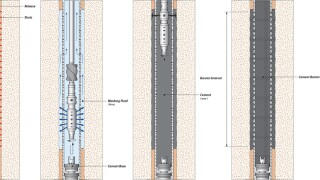Drilling
Oil and gas companies drilled 75 “high-impact” wells in 2024, representing 5.2 billion BOE.
This paper presents a comprehensive literature review of perforate, wash, and cement techniques that compares new methods with traditional ones and uses field cases and computational fluid dynamics to find the most cost- and time-effective practices without sacrificing safety.
The authors of this paper describe a method of stimulating a multizone hydrocarbon-producing well wherein a tool is deployed downhole by wireline to generate acid vapor at a target depth, allowing each interval to be treated uniquely.
-
Vimlesh Bavadiya is leading a team of engineering students at the University of Oklahoma (OU) to repeat its victory in SPE’s Drillbotics competition next year.
-
With the innovation of extended-reach and directional drilling, running casing and liner strings has become increasingly difficult.
-
While rotary-steerable systems (RSSs) dominate the offshore directional-drilling markets, the land-based markets are still dominated by conventional directional-drilling tools. This paper presents a new RSS that is being designed and tested specifically for the onshore markets.
-
The understanding and proper application of rotary-steerable systems will continue to provide a step change in the way fields are developed. Technology developed and implemented during the boom will receive closer scrutiny and evaluation during the bust.
-
Drilling the Severnaya Truba field in Aktobe, Kazakhstan, has been costly and time consuming.
-
The strength and conductivity of proppant packs are key parameters for assessing their performance. This paper introduces a new analysis technique based on interpretation of acoustic measurements to quantify mechanical damage in propping agents.
-
There is no doubt that horizontal and complex-geometry wells have contributed significantly to the reliable supply of affordable energy, resulting in improvements to the quality of life of people around the globe.
-
This paper presents experimental research in which a significant fracture-pressure increase was achieved in shale and the predominant wellbore strenghtening mechanism was identified.
-
This paper offers insight into an integrated effort at combining analytical information, numerical well-test models, and geological evidence to explain the reservoir behavior observed in the Huntington field.
-
For thin-oil-rim reservoirs, well placement, well type, well path, and the completion methods must be evaluated with close integration of key reservoir and production-engineering considerations.












